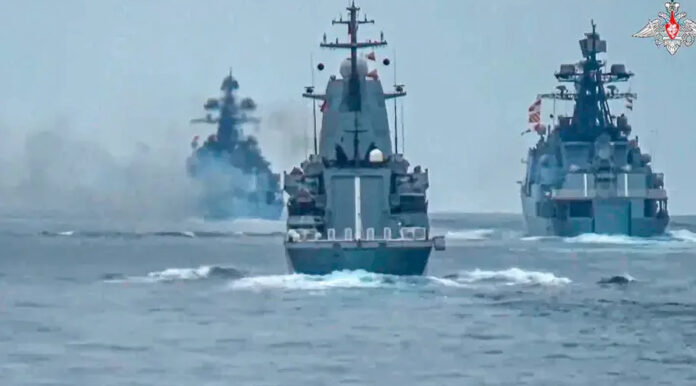CAIRO — A contingent of Russian warships has entered the volatile Red Sea region, state media reported on Thursday, sailing into an area beset by Houthi rebel attacks on commercial vessels and heavy naval traffic.
The Russian Pacific Fleet detachment includes the Varyag missile cruiser and Marshal Shaposhnikov frigate, according to the TASS news agency. It cited the fleet’s press service as saying the warships transited the Bab al-Mandeb Strait into the Red Sea to carry out “assigned tasks within the framework of a long-range maritime mission.”
The ultimate destination and purpose of the Russian deployment were not revealed. But the move adds more military muscle to an increasingly crowded and tensely contested waterway of global significance for trade and energy shipments.
For months, the Iran-backed Houthi rebels in Yemen have launched aerial attacks on ships transiting the Red Sea, including missiles strikes on tankers hauling Russian and Chinese oil cargoes. The militantgroup recently told Moscow and Beijing their commercial vessels could pass safely if granted political support at the United Nations.
Western navies have responded with airstrikes in Yemen targeting the Houthis, who say they are retaliating against the Saudi-led military coalition that has battled them since 2015. Despite a recent shipping security pact, aid workers worry any escalation could jeopardize supply lines for humanitarian aid to Yemen’s besieged population.
“The introduction of more warships from an outside power could insert another wild card into an increasingly complex security situation in the Red Sea,” said Michael Pricer, a maritime expert at the Arab Gulf States Institute in Washington. “All sides need to prioritize deescalation and freedom of navigation for commercial shipping.”
The Russian deployment follows recent joint naval drills with China and Iran in the Indian Ocean just outside the Red Sea’s southern entrance. Those trilateral exercises, which involved the same two Russian ships now in the Red Sea, focused on maritime security operations like intercepting piracy, according to Moscow’s defense ministry.
The arrival of the Russian warships adds to a potent array of naval forces already patrolling the strategic waterway bordering Yemen.
Since the surge in Houthi anti-ship attacks began in late 2022, the United States has maintained a carrier strike group in the region, coordinating air strikes against Houthi missile sites and coastal defenses. British and French warships have joined that maritime security effort.
Iran, the chief military backer of the Houthi rebel movement, also has a spy ship operating off Yemen’s coast to monitor the situation and potentially support Houthi operations, according to regional security sources.
Most international commercial shipping has been rerouted around the Cape of Good Hope at Africa’s southern tip to avoid the growing risks in the Red Sea region. But some vessels continue using the Red Sea corridor to transit between the Mediterranean and Indian Oceans.
It remains unclear whether the arrival of Russian naval power in the tense maritime theater is meant to project force or could play a stabilizing role to deescalate the violence and threats to global supply chains.
Russia has sought naval basing rights in the past on the Red Sea coast in the African nation of Sudan. However, Moscow’s plans for establishing a permanent military foothold were thrown into doubt by the eruption of armed conflicts between rival Sudanese factions last year.
For now, Pricer said, the main Russian maritime priorities appear to be power projection and safeguarding its economic interests like protecting shipments of its oil exports that have been targeted by the Houthis.
“By sending warships, Russia is signaling that it has a stake in maintaining freedom of navigation in the Red Sea, especially for its own commercial shipping interests,” he said. “But their mere presence also carries escalation risks in such a volatile area.”
Russia’s TASS report provided no details on the planned activities or duration of the Red Sea maritime mission by the Pacific Fleet ships.
This is a high-stakes region for Russia to engage in military operations. Mishaps or unintended confrontations could ignite a wider conflict drawing in Saudi Arabia and its coalition partners against the Iran-linked Houthis. The rebels’ arsenal of drones, missiles and sea mines also poses constant threats.
In January, the Houthis fired missiles that detonated near a Russian-operated commercial tanker, just days after their leaders assured Moscow that Russian vessels would not be targeted.
The United Nations has warned that any disruption to shipping traffic through the Red Sea could trigger a spike in global energy and food prices amid tight supply chains. That could dealing a punishing blow to many countries still reeling from economic turmoil unleashed by the Covid-19 pandemic and Russia’s war in Ukraine.
With so much at stake, all sides will be closely watching Russia’sfirst naval operations in the flashpoint Red Sea corridor.





















